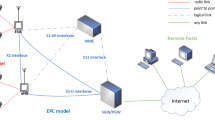Abstract
Recently, the research on the interworking between 3G cellular networks and WLANs is actively being constructed. To integrate these two technologies, there are many issues such as the network architecture, mobility management, and security which should be solved. During vertical handoff, some undesirable phenomena may mistakenly trigger TCP congestion control operations and thus degrade TCP performance. In this paper, we propose an approach that can quickly estimate available bandwidth when a mobile node (MN) handoff occurs. A sender updates the adaptive slow-start threshold (ssthresh) and congestion window size (cwnd) to improve TCP performance during soft vertical handoff in hybrid mobile networks. Our scheme requires only minor modifications of the transport layer of the end hosts. Simulation results show that our scheme effectively improves the TCP performance.
Similar content being viewed by others
References
Allman, M., Paxson, V., & Stevens, W. Richard (1999). “TCP Congestion Control, ” RFC 2581, Internet engineering task force, April.
Balakrishnan, H., Seshan, S., Amir, E., & Katz, Randy H. (2002). Improving TCP/IP performance over wireless networks. ACM Computing Surveys, 34, 357–374.
Da Costa, G. M. T., & Sirisena, H. R. (2002). Freeze TCP with timestamps for fast packet loss recovery after disconnections. In Proceedings of the international symposium on performance evaluation of computer and telecommunication systems, July.
Caceres, R., & Iftode, L. (1995). Improving the performance of reliable transport protocols in mobile computing environments. IEEE Journal on Selected Areas in Communications, 13(5).
Elaarag, H. (2002). Improving TCP performance over mobile networks. ACM Computing Surveys, 34(3), 357–374.
Goff, T., Moronski, J., Phatak, D. S., & Gupta, V. (2000). Freeze-TCP: a true end-to-end TCP enhancement mechanism for mobile environments. In Proceedings of the IEEE INFOCOM (Vol. 3, pp. 1537–1545), March.
Guerrero, J. A., & Barba, A. (2008). Policy-based network management reference architecture for an integrated environment WLAN-3G. IEEE Latin America Transactions, 6(2), 229–235.
Izumikawa, H., Yamaguchi, I., & Katto, J. (2004). An efficient TCP with explicit handover notification for mobile networks. In Proceedings of the IEEE wireless communications and networking conference (Vol. 2, pp. 647–652), March.
Jacobson, V., & Karels, V. M. (1988). Congestion avoidance and control. ACM Computer Communication Review, 18, 314–329.
Kim, S. E., Copeland, J. A., Chen, C., Wang, L., Liu, L., & Wu, W. (2004). Interworking between WLANs and 3G networks: TCP challenges. In Proceedings of the 2004 IEEE wireless communications and networking conference (Vol. 2, pp. 1252–1257), March
Li, S., Chong, S., & Hwang, C. (1995). Link capacity allocation and network control by filtered input rate in high-peed networks. IEEE/ACM Transactions on Networking, 3, 10–25.
Mark, J. W., Pan, J., & Shen, S. X. (2003). Mobility support in hybrid wireless/IP networking. Computer Communications, 26, 1990–1997.
Mascolo, S. (2001). TCP Westwood: bandwidth estimation for enhanced transport over wireless links. In ACM MOBICOM, July.
Postel, J. (1981). Transmission control protocol. RFC 793, Internet engineering task force, September.
Shi, M., Rutagemwa, H., Shen, X., Mark, J. W., & Saleh, A. (2007). A service-agent-based roaming architecture for WLAN/Cellular integrated networks. IEEE Transactions on Vehicular Technology, 56(5), 3168–3181.
Stemm, M., & Katz, R. H. (1998). Vertical handoffs in wireless overlay networks. In ACM mobile networking and applications (MONET) (Vol. 3, pp. 335–350), March.
Stevens, W. (1981). TCP slow start, congestion avoidance, fast retransmit, and fast recovery algorithms. RFC 2001, Internet engineering task force, September.
Soliman, H., Castelluccia, C., El Malki, K., & Bellier, L. (2005). Hierarchical MIPv6 mobility management. RFC 4140, Internet engineering task force, August.
Stevens, W. (1994). TCP/IP illustrated (Vol. 1). Reading: Addison-Wesley.
The Network Simulator 2 (2011). http://www.isi.edu/nsnam/ns/index.html.
Vassiliou, V., Owen, H. L., Barlow, D. A., Grimminger, J., Huth, H. P., & Sokol, J. (2002). A radio access network for next generation wireless networks based on multi-protocol label switching and hierarchical mobile IP. In Proceedings of the 2002 IEEE vehicular technology conference (Vol. 2, 782–786), July.
Author information
Authors and Affiliations
Corresponding author
Rights and permissions
About this article
Cite this article
Wang, NC., Chen, YL., Cheng, CH. et al. Improving TCP performance with fast adaptive congestion control during soft vertical handoff. Telecommun Syst 52, 97–104 (2013). https://doi.org/10.1007/s11235-011-9463-y
Published:
Issue Date:
DOI: https://doi.org/10.1007/s11235-011-9463-y




